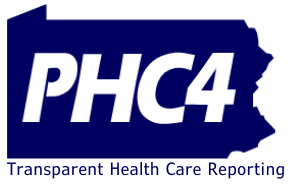When researchers and policymakers seek data to study national or regional trends in health care, they often look to the Healthcare Cost and Utilization Project (HCUP), a federally-funded nationwide resource for health care data sponsored by the Agency for Healthcare Research and Quality (AHRQ).
As a partner organization, the Pennsylvania Health Care Cost Containment Council (PHC4) annually provides information about inpatient hospital stays for HCUP, the largest all-payer, encounter-level collection of hospital data in the US. HCUP includes data on utilization, access, charges, quality and outcomes of hospital care.
PHC4 is one of 46 organizations contributing data to HCUP for the State Inpatient Databases (SID), a powerful collection of inpatient hospital information representing 97% of all US hospital discharges. The data PHC4 provides is available for internal research by AHRQ and to create several derivative databases, tools and analyses.
AHRQ senior research scientist, Anne Elixhauser, PhD, said PHC4’s inpatient discharge datasets are vital to support national and regional estimates through the Nationwide Inpatient Sample (NIS), a uniform, multi-state database which approximates a 20% sample of US community hospitals and contains approximately 8 million hospital stays per year.
“Pennsylvania is a big state and its data is critical to provide a balanced picture of what is happening nationally, and especially in the Northeast region,” said Dr. Elixhauser.
As the largest annual all-payer database in the nation, the NIS allows for studies about relatively uncommon conditions and procedures for all payers, as well as research on specific groups of people such as infants with special needs, the elderly or the uninsured. In addition to being used by researchers for a huge number of studies (currently over 1,600), the NIS is used in HCUP statistical briefs covering a wide range of topics, such as Hospitalizations for Eating Disorders (#120), Hospital Visits in the U.S. for Firearm-related Injuries, 2009 (#136), and Pediatric Cancer Hospitalizations, 2009 (#132). More statistical briefs can be found at http://www.hcup-us.ahrq.gov/reports/statbriefs/statbriefs.jsp.
Another HCUP database that includes PHC4 data is the Kids’ Inpatient Database (KID), the only database designed to study children’s use of hospital services, outcomes and charges in the US.
One useful interactive tool, HCUPnet, is a free online query system that provides immediate access to descriptive statistics from HCUP data. Using a step-by-step query system, users can generate tables and graphs on national and regional statistics. HCUPnet is available at http://hcupnet.ahrq.gov/.
In addition, the HCUP data, including PHC4 data, is used to develop the AHRQ Quality Indicators (QIs), measures of health care quality that make use of readily available inpatient administrative data to help hospitals identify potential quality of care issues and track changes over time. These QIs, representing various aspects of quality, are used in free software distributed by AHRQ. More information is available at http://qualityindicators.ahrq.gov.
Another important use of HCUP data is for AHRQ’s annual reports on progress and opportunities for improving health care quality and reducing health care disparities in the US, as mandated by Congress. AHRQ’s National Healthcare Quality Report (NHQR) addresses the status of health care quality, areas for quality improvement, and how health care delivered to Americans is changing over time. For the most recent report, go to http://www.ahrq.gov/qual/nhqr11/nhqr11.pdf.
PHC4 is pleased to support HCUP through this federal/state/ industry partnership to provide comprehensive, accurate and timely data for use in evaluating cost, quality and access to health care.
Return to the Case Studies page: VIEW ALL CASE STUDIES


